新目标英语中考课本考点归纳复习
中考资料新目标九年级英语全部单元知识点、短语及句型总结
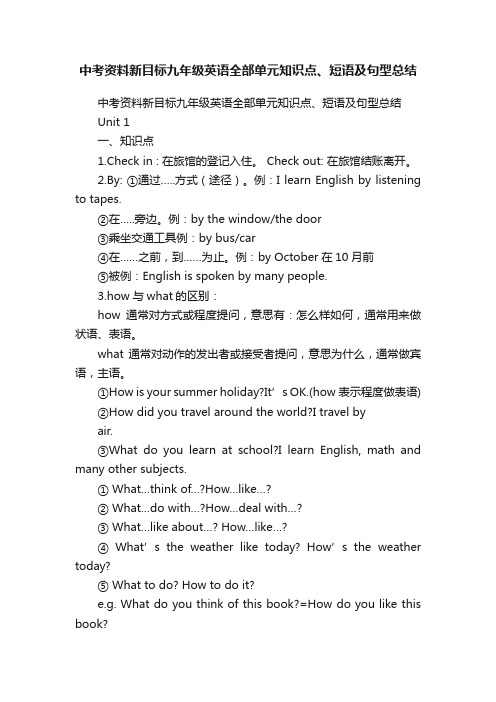
中考资料新目标九年级英语全部单元知识点、短语及句型总结中考资料新目标九年级英语全部单元知识点、短语及句型总结Unit 1一、知识点1.Check in : 在旅馆的登记入住。
Check out: 在旅馆结账离开。
2.By: ①通过…..方式(途径)。
例:I learn English by listening to tapes.②在…..旁边。
例:by the window/the door③乘坐交通工具例:by bus/car④在……之前,到……为止。
例:by October在10月前⑤被例:English is spoken by many people.3.how与what的区别:how通常对方式或程度提问,意思有:怎么样如何,通常用来做状语、表语。
what通常对动作的发出者或接受者提问,意思为什么,通常做宾语,主语。
①How is your summer holiday?It’s OK.(how表示程度做表语)②How did yo u travel around the world?I travel byair.③What do you learn at school?I learn English, math and many other subjects.① What…think of…?How…like…?② What…do with…?How…deal with…?③ What…like about…? How…like…?④ What’s the weather like today? How’s the weather today?⑤ What to do? How to do it?e.g. What do you think of this book?=How do you like this book?I don’t know what I should do with the matter.=I don’t know how I should deal with it.What do you like about China?=How do you like China?I don’t know what to do next step?=I don’t know how to do it next step?㊣ What good / bad weather it is today!(weather 为不可数名词,其前不能加 a )㊣ What a fine / bad day it is today! (day为可数名词,其前要加 a )4. aloud, loud与loudly的用法: 三个词都与"大声"或"响亮"有关。
202X年英语知识点汇总人教新目标九年级

千里之行,始于足下。
202X年英语知识点汇总人教新目标九年级2020年英语知识点汇总(人教新目标九年级)一、语法知识点1. 一般现在时和现在进行时2. 一般过去时和过去进行时3. 现在完成时和过去完成时4. 将来时和过去将来时5. 被动语态6. 定语从句7. 名词性从句8. 直接引语和间接引语9. 虚拟语气10. 并列连词和从属连词的用法11. 条件句的用法12. 状语从句的用法13. 宾语从句的用法14. 主谓一致的考点15. 各种名词的用法、单复数等二、词汇知识点1. 动词动名词的用法2. 形容词的比较级和最高级3. 副词的比较级和最高级4. 形容词和副词的用法第1页/共3页锲而不舍,金石可镂。
5. 复合词的构成和词义6. 介词短语的用法7. 词义辨析8. 词组和固定搭配9. 常用短语和习惯用法10. 习惯用法的辨析11. 词形转换和派生词的用法12. 各种词类的用法13. 词汇的辨析和用法三、阅读理解1. 认字识词2. 词义猜测3. 阅读顺序4. 推理判断5. 阅读理解题型6. 文章主旨大意7. 文章结构8. 文章出处和作者意图9. 文章的背景和情节10. 文章的观点和态度四、写作技巧1. 书信的格式和写作方法2. 日记的写作技巧和模板3. 描写人物和事物的方法和技巧4. 叙事文的基本结构和写作方法5. 说明文的写作结构和方法千里之行,始于足下。
6. 议论文的写作方法和写作要点7. 描写环境的方法和技巧8. 写人的方法和技巧9. 文章的开头结尾的写作方法10. 给与建议和提出要求的写作方法五、口语和听力技巧1. 听力技巧和短文理解2. 表达观点和意见的口语表达3. 描述个人经历和事件的口语表达4. 提问和回答的技巧和表达方式5. 谈论过去和将来的口语表达6. 演讲和口头报告的技巧和写作方法7. 各种口语问答的技巧和表达方式8. 倾听和回答问题的技巧和方法9. 讨论和辩论的技巧和写作方法10. 口语表达的流利程度和准确性第3页/共3页。
5.人教新目标中考英语重点知识点归纳(记忆版)

重点知识点归纳--中考精华版(人教新目标)1.What's this in English?这个用英语怎么说?【考点精讲】(1)What是疑问词,意为“什么”,经常用来提问姓名、物品、颜色、各种号码、干什么以及身份或职业等。
eg:What is your name?你叫什么名字?What color is it?它是什么颜色的?(2)in English意为“用英语”,“in+某种语言”意为“用……语言”。
eg:in Chinese用汉语in Japanese用日语2、Excuse me,Grace.Is this your pencil?打扰了,格雷丝。
这是你的铅笔吗?【考点精讲】(1)Excuse me是会话时常用的客套话,常用在句首,有“劳驾;请问;请原谅;对不起,打扰了”等意思。
它常用于以下几种场合:①当你要向他人询问一件事时;②当你有事请他人帮忙时;③当你向别人问路时。
eg:Excuse me.Can you help me,please?劳驾。
请你帮我一下好吗?【拓展】◆Sorry.是I'm sorry.的省略形式,是说错话、做错事、认错人等之后向对方致歉的用语,其答语通常是That's all right/Not at all/Never mind/It doesn't matter.等。
eg:—I'm sorry,I'm late.对不起,我迟到了。
—That's all right.没关系。
◆Pardon是I beg your pardon的省略形式,常用于正式的场合,当做错了事向别人道歉,意为“请你原谅”;当没听清对方的话,请求重复时,意为“请再说一遍”。
eg:—May I ask you a question?我可以问你一个问题吗?—Pardon?请再说一遍。
(2)Is this…?常用来询问近处的物或人,意为“这是……吗?”而Is that…?则是询问远处的物或人,意为“那是……吗?”。
新目标中考英语九年级全册知识+初中三年中考语法知识点做题技巧,阅读理解方法解析
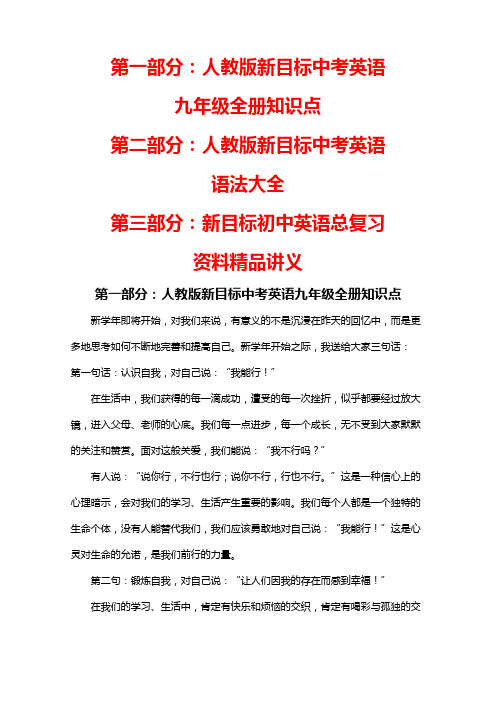
②loud 可作形容词或副词。用作副词时,常与 speak, talk, laugh 等动词连用,多用于比较级,须放在动词之后。如: She told us to speak a little louder. 她让我们说大声一点。 ③loudly 是副词,与 loud 同义,有时两者可替换使用,但往往 含有令人讨厌或打扰别人的意思,可位于动词之前或之后。如: talk loudly or laugh loudly in public. 他不当众大声谈笑。 7. not …at all 一点也不 根本不 如: He does not
The thief entered the room by the window. The student went to park by bus. 2. talk about 谈论, 议论, 讨论 如: The students often talk about
movie after class. 学生们常常在课后讨论电影。 talk to sb. === talk with sb. 与某人说话 3. 提建议的句子: ①What/ how about +doing sth.? 如:What/ How about going shopping? ②Why don’t you + do sth.? 如:Why don’t you go shopping? ③Why not + do sth. ? ④Let’s + do sth. ⑤Shall we/ I + do sth.? 4. a lot 许多 如:Why not go shopping? 如: Let’s go shopping 如:Shall we/ I go shopping?
第一部分:人教版新目标中考英语 九年级全册知识点 第二部分:人教版新目标中考英语 语法大全 第三部分:新目标初中英语总复习 资料精品讲义
新目标初中英语知识点总结

新目标初中英语知识点总结一、词汇与语法1. 词汇积累- 常用生活词汇:学习与生活中常用的名词、动词、形容词和副词,如学习用品、家庭成员、日常活动等。
- 话题相关词汇:根据不同话题,如学校生活、个人兴趣、节假日等,扩展相关词汇。
- 词性转换:掌握名词、动词、形容词之间的转换规则,如动词+er/ing 转名词,形容词比较级和最高级形式。
2. 基础语法- 时态:一般现在时、一般过去时、一般将来时、现在进行时等基本时态的构成和用法。
- 句型结构:简单句的五种基本句型,如主语+谓语、主语+谓语+宾语等。
- 代词:人称代词、物主代词、反身代词、指示代词、疑问代词的用法。
- 冠词:不定冠词a/an的用法,定冠词the的用法及其区别。
- 介词:常用介词如in, on, at, for, with等的用法及其固定搭配。
- 连词:并列连词and, but, or等的用法,以及从属连词如because, when, if等引导的从句。
二、阅读理解1. 阅读技巧- 快速阅读:通过扫读(Skimming)和查读(Scanning)快速获取文章大意和细节信息。
- 关键词定位:在阅读理解题中,学会根据问题关键词定位到文章相关段落。
- 逻辑推理:根据上下文线索,进行逻辑推理以理解文章隐含意义。
2. 题型解析- 事实细节题:直接从文章中找到答案,注意准确和细致。
- 主旨大意题:理解文章的中心思想或标题,通常不直接出现在文章中。
- 推理判断题:根据文章内容进行逻辑推理,得出结论。
- 词义猜测题:根据上下文推测生词或短语的含义。
三、写作技巧1. 文章结构- 开头:引入话题,明确文章主题。
- 正文:分段阐述观点,每段一个中心句,后跟支持细节。
- 结尾:总结全文,呼应开头,或提出建议和展望。
2. 写作类型- 描述性写作:描述人物、地点、事件等,注意使用形容词和副词。
- 叙事性写作:讲述故事或事件,注意时态和顺序。
- 议论性写作:表达个人观点,给出理由和例证,注意逻辑性和说服力。
初中新目标英语中考总复习英语版动词+doing和+to do
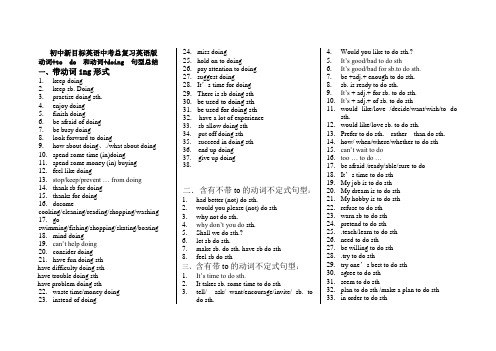
初中新目标英语中考总复习英语版动词+to do 和动词+doing 句型总结一、带动词ing形式1.keep doing2.keep sb. Doing3.practise doing sth.4.enjoy doing5.finish doing6.be afraid of doing7.be busy doing8.look forward to doing9.how about doing、./what about doing10.spend some time (in)doing11.spend some money (in) buying12.feel like doing13.stop/keep/prevent … from doing14.thank sb for doing15.thanks for doing16.dosomecooking/cleaning/reading/shopping/washing 17.goswimming/fishing/shopping/skating/boating18.mind doing19.can’t help doing20.consider doing21.have fun doing sthhave difficulty doing sthhave trouble doing sthhave problem doing sth22.waste time/money doing23.instead of doing 24.miss doing25.hold on to doing26.pay attention to doing27.suggest doing28.It’s time for doing29.There is sb doing sth30.be used to doing sth31.be used for doing sth32. have a lot of experience33. sb allow doing sth34. put off doing sth35. succeed in doing sth36. end up doing37. give up doing38.二.含有不带to的动词不定式句型:1.had better (not) do sth.2.would you please (not) do sth3.why not do sth.4.why don’t you do sth.5.Shall we do sth.?6.let sb do sth.7.make sb. do sth. have sb do sth8.feel sb do sth三、含有带to的动词不定式句型:1.It’s time to do sth.2.It takes sb. some time to do sth3.tell/ ask/ want/encourage/invite/ sb. todo sth.4.Would you like to do sth.?5.It’s good/bad to do sth6.It’s good/bad for sb.to do sth.7.be +adj.+ enough to do sth.8.sb. is ready to do sth.9.It’s + adj.+ for sb. to do sth.10.It’s + adj.+ of sb. to do sth11.would like/love /decide/want/wish/to dosth.12.would like/love sb. to do sth.13.Prefer to do sth. rather than do sth.14.how/ when/where/whether to do sth15.can’t wait to do16.too … to do …17.be afraid /ready/able/sure to do18.It’s time to do sth19.My job is to do sth20.My dream is to do sth21.My hobby is to do sth22.refuse to do sth23.warn sb to do sth24.pretend to do sth25..teach/learn to do sth26.need to do sth27.be willing to do sth28..try to do sth29.try one’s best to do sth30.agree to do sth31.seem to do sth32.plan to do sth /make a plan to do sth33.in order to do sth34.have a chance to do sth35.find it +adj + for sb to do sth36.have sth to do37.There is sth for sb to do38.be anxious to do39.afford to do sth40.两个动作连用,表目的ed to do sth42.be used to do sth43.be supposed to do sth44.allow sb to do sth45.sb be allowed to do sth46.the best way is to do sth47.the next step is to do sth48.have nothing to do with49.the first thing is to do sth50.it’s best to do sth51.it’s a good time to do sth52.it is a good way to do sth53.add to do54.urge sb to docate sb to do56.wait for sb to do57.order sb to do58.happen to do sth59.lead sb to do sth60.it’ a good place to do sth61.invite sb to do62.get to do sth63.expect to do64.volunteer to do sth 65.offer to do sth66.have an opportunity to do67.get sb to do sth68.it’s one’s duty to do sthe sth to do sth70.be sure to do sth71.have to do sth72.be able/unable to do sth四、既用带to的动词不定式又用ing形式的句型:1.stop to do/ doing2.forget to do/ doing3.remember to do/doing4.go on to do/doing5.like to do/doing6.love to do/doing7.prefer to do/doing8.hate to do/doing五、下列结构用带to的动词不定式和ing形式含义相同:、1..begin to do/doing2.start to do/doing3.continue to do/doing4.take turns to do/doing六、既用不带to的动词不定式又用现在分词的句型:用不带to的动词不定式强调动作的完成过程;用现在分词强调动作的进行状态。
新目标中考英语九年级全册知识点

【九年级英语1】1. + 通过……方式如: a还可以表示:“在…旁”、“靠近”、“在…期间”、“用、”“经过”、“乘车”等如:I .I o’...2. 谈论,议论,讨论如: . 学生们常常在课后讨论电影。
. . 与某人说话3. 提建议的句子:① .?如:?② ’t + .? 如:’t ?③ + . ? 如:?④’s + . 如:’s⑤ I + .? 如:I ?4. a 许多常用于句末如:I a . 我吃了许多。
5. … 太…而不能常用的句型 . + .如:I’m . 我太累了,什么都不想说。
6. , 与的用法三个词都与"大声"或"响亮"有关。
①是副词,重点在出声能让人听见,但声音不一定很大,常用在读书或说话上。
通常放在动词之后。
没有比较级形式。
如: .他朗读那篇故事给他儿子听。
②可作形容词或副词。
用作副词时,常与, ,等动词连用,多用于比较级,须放在动词之后。
如:a . 她让我们说大声一点。
③是副词,与同义,有时两者可替换使用,但往往含有令人讨厌或打扰别人的意思,可位于动词之前或之后。
如: .他不当众大声谈笑。
7. … 一点也不根本不如:I . I ’t .我非常喜欢牛奶。
我一点也不喜欢咖啡。
经常可以和助动词结合在一起,则放在句尾8. / ./ .. 对…感兴奋如:I / .I . 我对去北京感到兴奋。
9. ① 终止做某事,结束做某事如:. 晚会以唱歌而结束。
② . 以…结束如:. 晚会以她的歌唱而告终。
10. 首先. 一开始后来、随11. 也、而且(用于肯定句)常在句子的中间也(用于否定句)常在句末也(用于肯定句) 常在句末12. 犯错如:I . 我经常犯错。
a 犯一个错误如:I a .我已经犯了一个错误。
13. . 笑话;取笑(某人)如:’t !不要取笑我!14. 做笔记,做记录15. . 喜欢做…乐意做… 如:. 她喜欢踢足球。
过得愉快如: . 他过得愉快。
新目标九年级英语知识点(考点精华)
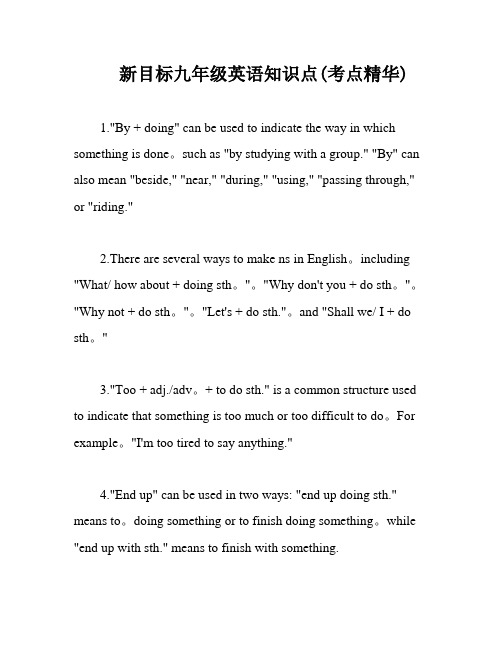
新目标九年级英语知识点(考点精华)1."By + doing" can be used to indicate the way in which something is done。
such as "by studying with a group." "By" can also mean "beside," "near," "during," "using," "passing through," or "riding."2.There are several ways to make ns in English。
including "What/ how about + doing sth。
"。
"Why don't you + do sth。
"。
"Why not + do sth。
"。
"Let's + do sth."。
and "Shall we/ I + do sth。
"3."Too + adj./adv。
+ to do sth." is a common structure used to indicate that something is too much or too difficult to do。
For example。
"I'm too tired to say anything."4."End up" can be used in two ways: "end up doing sth." means to。
新目标英语中考考点全部汇总
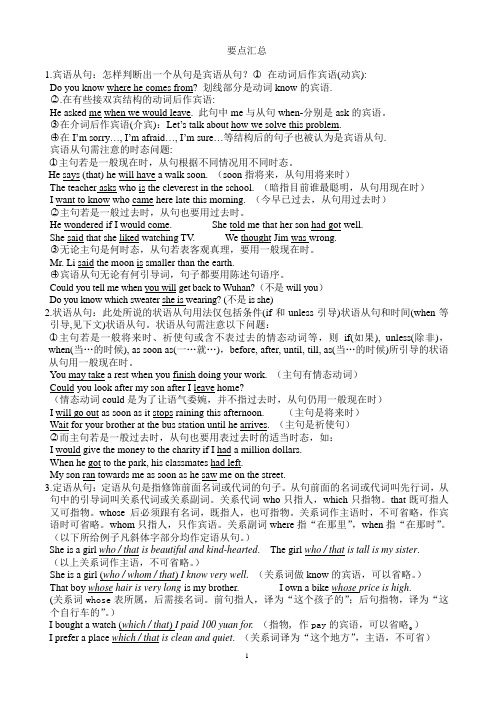
要点汇总1.宾语从句:怎样判断出一个从句是宾语从句?◈1在动词后作宾语(动宾):Do you know where he comes from? 划线部分是动词know的宾语.◈2.在有些接双宾结构的动词后作宾语:He asked me when we would leave. 此句中me与从句when-分别是ask的宾语。
◈3在介词后作宾语(介宾):Let’s talk about how we solve this problem.◈4在I’m sorry…, I’m afraid…, I’m sure…等结构后的句子也被认为是宾语从句.宾语从句需注意的时态问题:◈1主句若是一般现在时,从句根据不同情况用不同时态。
He says (that) he will have a walk soon. (soon指将来,从句用将来时)The teacher asks who is the cleverest in the school. (暗指目前谁最聪明,从句用现在时)I want to know who came here late this morning. (今早已过去,从句用过去时)◈2主句若是一般过去时,从句也要用过去时。
He wondered if I would come. She told me that her son had got well.She said that she liked watching TV. We thought Jim was wrong.◈3无论主句是何时态,从句若表客观真理,要用一般现在时。
Mr. Li said the moon is smaller than the earth.◈4宾语从句无论有何引导词,句子都要用陈述句语序。
Could you tell me when you will get back to Wuhan?(不是will you)Do you know which sweater she is wearing? (不是is she)2.状语从句:此处所说的状语从句用法仅包括条件(if和unless引导)状语从句和时间(when等引导,见下文)状语从句。
新目标中考英语九年级全册知识点

【九年级英语Unit1】1. by + doing 通过……方式 如:by studying with a group by 还可以表示:“在…旁”、“靠近”、“在…期间”、“用、” “经过”、“乘车”等 如:I live by the river.I have to go back by ten o ’clock.The thief entered the room by the window. The student went to park by bus.2. talk about 谈论,议论,讨论 如:The students often talk aboutmovie after class. 学生们常常在课后讨论电影。
talk to sb. === talk with sb. 与某人说话 3. 提建议的句子:①What/ how about +doing sth.?如:What/ How about going shopping?②Why don’t you + do sth.? 如:Why d on’t you go shopping? ③Why not + do sth. ? 如:Why not go shopping? ④Let ’s + do sth. 如: Let ’s go shopping⑤Shall we/ I + do sth.? 如:Shall we/ I go shopping? 4. a lot 许多 常用于句末 如:I eat a lot. 我吃了许多。
5. too …to 太…而不能 常用的句型 too+adj./adv. + to do sth.如:I’m too tired to say anything. 我太累了,什么都不想说。
6. aloud, loud 与loudly 的用法三个词都与"大声"或"响亮"有关。
新目标英语九年级(全册)知识点归纳

新目标英语九年级(全册)知识点归纳New Target English Grade 9 SummaryUnit 11.Ways of using "by" include indicating method。
proximity。
n。
means of ___。
etc。
For example。
"by studying with a group," "I live by the river," "I have to go back by ten o'clock," "The thief entered the room by the window," and "The studentwent to the park by bus."2.The sentence pattern "too + adj./adv。
+ to do sth." means that someone is too something to do something else。
For example。
"I'm too tired to say anything."3."___." ___ to do sth." For example。
"I am excited about going to Beijing" or "I am excited to go to Beijing."4."End up doing sth" means to ___ doing something。
For example。
"The party ended up singing." "End up with sth" meansto end with something。
新目标版_九年级英语中考复习课本、语法重点复习(已排版)
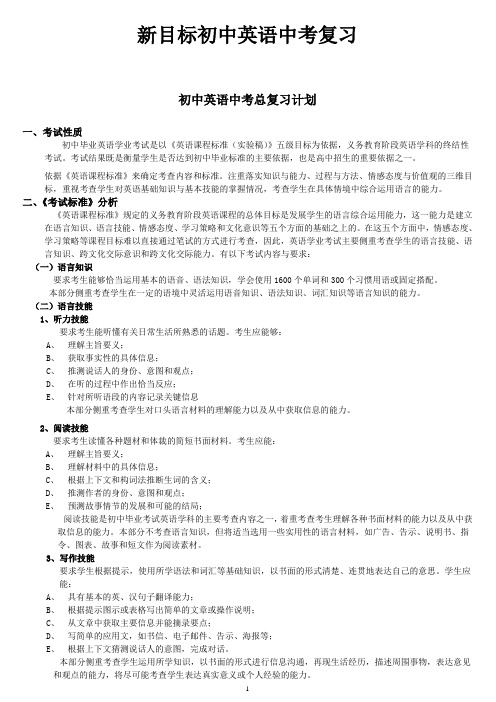
新目标初中英语中考复习初中英语中考总复习计划一、考试性质初中毕业英语学业考试是以《英语课程标准(实验稿)》五级目标为依据,义务教育阶段英语学科的终结性考试。
考试结果既是衡量学生是否达到初中毕业标准的主要依据,也是高中招生的重要依据之一。
依据《英语课程标准》来确定考查内容和标准。
注重落实知识与能力、过程与方法、情感态度与价值观的三维目标,重视考查学生对英语基础知识与基本技能的掌握情况,考查学生在具体情境中综合运用语言的能力。
二、《考试标准》分析《英语课程标准》规定的义务教育阶段英语课程的总体目标是发展学生的语言综合运用能力,这一能力是建立在语言知识、语言技能、情感态度、学习策略和文化意识等五个方面的基础之上的。
在这五个方面中,情感态度、学习策略等课程目标难以直接通过笔试的方式进行考查,因此,英语学业考试主要侧重考查学生的语言技能、语言知识、跨文化交际意识和跨文化交际能力。
有以下考试内容与要求:(一)语言知识要求考生能够恰当运用基本的语音、语法知识,学会使用1600个单词和300个习惯用语或固定搭配。
本部分侧重考查学生在一定的语境中灵活运用语音知识、语法知识、词汇知识等语言知识的能力。
(二)语言技能1、听力技能要求考生能听懂有关日常生活所熟悉的话题。
考生应能够:A、理解主旨要义;B、获取事实性的具体信息;C、推测说话人的身份、意图和观点;D、在听的过程中作出恰当反应;E、针对所听语段的内容记录关键信息本部分侧重考查学生对口头语言材料的理解能力以及从中获取信息的能力。
2、阅读技能要求考生读懂各种题材和体裁的简短书面材料。
考生应能:A、理解主旨要义;B、理解材料中的具体信息;C、根据上下文和构词法推断生词的含义;D、推测作者的身份、意图和观点;E、预测故事情节的发展和可能的结局;阅读技能是初中毕业考试英语学科的主要考查内容之一,着重考查考生理解各种书面材料的能力以及从中获取信息的能力。
本部分不考查语言知识,但将适当选用一些实用性的语言材料,如广告、告示、说明书、指令、图表、故事和短文作为阅读素材。
新目标九年级英语全册知识要点
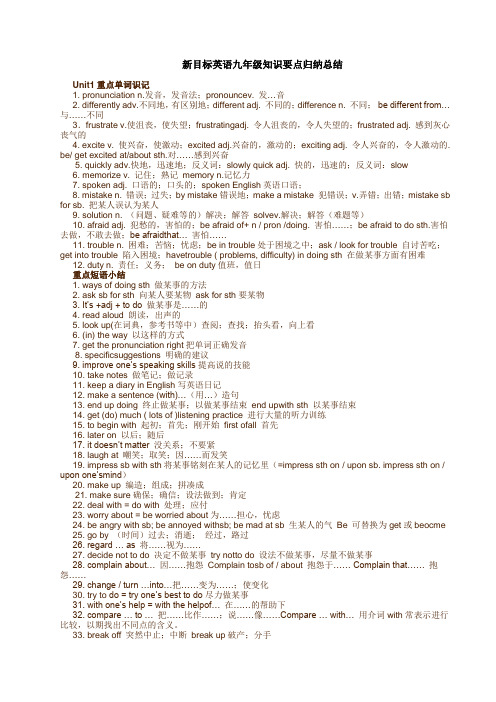
新目标英语九年级知识要点归纳总结Unit1重点单词识记1. pronunciation n.发音,发音法;pronouncev. 发…音2. differently adv.不同地,有区别地;different adj. 不同的;difference n. 不同;be different from…与……不同3.frustrate v.使沮丧,使失望;frustratingadj. 令人沮丧的,令人失望的;frustrated adj. 感到灰心丧气的4. excite v. 使兴奋,使激动;excited adj.兴奋的,激动的;exciting adj. 令人兴奋的,令人激动的. be/ get excited at/about sth.对……感到兴奋5. quickly adv.快地,迅速地;反义词:slowly quick adj. 快的,迅速的;反义词:slow6. memorize v. 记住;熟记memory n.记忆力7. spoken adj. 口语的;口头的;spoken English英语口语;8. mistake n. 错误;过失;by mistake错误地;make a mistake 犯错误;v.弄错;出错;mistake sb for sb. 把某人误认为某人9. solution n. (问题、疑难等的)解决;解答solvev.解决;解答(难题等)10. afraid adj. 犯愁的,害怕的;be afraid of+ n / pron /doing. 害怕……;be afraid to do sth.害怕去做,不敢去做;be afraidthat… 害怕……11. trouble n. 困难;苦恼;忧虑;be in trouble处于困境之中;ask / look for trouble 自讨苦吃;get into trouble 陷入困境;havetrouble ( problems, difficulty) in doing sth 在做某事方面有困难12. duty n. 责任;义务;be on duty值班,值日重点短语小结1. ways of doing sth 做某事的方法2. ask sb for sth 向某人要某物ask for sth要某物3. It’s +adj + to do 做某事是……的4. read aloud 朗读,出声的5. look up(在词典,参考书等中)查阅;查找;抬头看,向上看6. (in) the way 以这样的方式7. get the pronunciation right把单词正确发音8. specificsuggestions 明确的建议9. improve one’s speaking skills提高说的技能10. take notes 做笔记;做记录11. keep a diary in English写英语日记12. make a sentence (with)…(用…)造句13. end up doing 终止做某事;以做某事结束end upwith sth 以某事结束14. get (do) much ( lots of )listening practice 进行大量的听力训练15. to begin with 起初;首先;刚开始first ofall 首先16. later on 以后;随后17. it doesn’t matter 没关系;不要紧18. laugh at 嘲笑;取笑;因……而发笑19. impress sb with sth将某事铭刻在某人的记忆里(=impress sth on / upon sb. impress sth on / upon one’smind)20. make up 编造;组成;拼凑成21. make sure确保;确信;设法做到;肯定22. deal with = do with 处理;应付23. worry about = be worried about为……担心,忧虑24. be angry with sb; be annoyed withsb; be mad at sb 生某人的气Be 可替换为get或beocme25. go by (时间)过去;消逝;经过,路过26. regard … as 将……视为……27. decide not to do 决定不做某事try notto do 设法不做某事,尽量不做某事28. complain about… 因……抱怨Complain tosb of / about 抱怨于…… Complain that…… 抱怨……29. change / turn …into…把……变为……;使变化30. try to do = try one’s best to do尽力做某事31. with one’s help = with the helpof… 在……的帮助下32. compare … to … 把……比作……;说……像……Compare … with… 用介词with常表示进行比较,以期找出不同点的含义。
- 1、下载文档前请自行甄别文档内容的完整性,平台不提供额外的编辑、内容补充、找答案等附加服务。
- 2、"仅部分预览"的文档,不可在线预览部分如存在完整性等问题,可反馈申请退款(可完整预览的文档不适用该条件!)。
- 3、如文档侵犯您的权益,请联系客服反馈,我们会尽快为您处理(人工客服工作时间:9:00-18:30)。
新目标英语中考课本考点归纳复习新目标英语中考课本考点归纳复习2010-08-12 来源:网络[字号:大中小]七年级上册(Unit 1____Unit 12)考点归纳考点1.Thanks for doing sthEg . Thanks for having us .考点2.Here is / are …Eg .Here is a letter for youHere are some frowers for you .考点3.take /bringtake 带/拿走, 把sb./sth.从说话处带到别处bring 带来/拿来 ,把sb./sth.从别处带到说话处eg .The food is bad ,please take it away .Please bring your homework here tomorrow .考点4.have 用法1).肯定句: Sb/Sth +have/has/had +….2).否定句: Sb/Sth +don’t /doesn’t /didn’t +have …3).疑问句: Do/Does/Did +sb/sth +have +…?回答: Yes, sb +do /does /didNo, sb +don’t /doesn’t /didn’t考点5.Let’s + do sth考点6.like 的用法1) like sth2)like to do sth /like doing sth3)like sb to do sth考点7.询问价格How much +be +sth ? = What’s the price of sth?考点8.Can I help you ? = What can I do for you ?考点9.I’ll take it = I’ll buy it考点10.price 作名词, “价格,价钱” 以…价格, 用介词 at .at a low /high price 以低/高价…考点11.aslo /too / either1)also /too 表示“也” 用于肯定句 ,aslo 用于句中, too 用于句末.2)either 用于否定句的句末.考点12.询问sb 的生日是什么时候?When is one’s birthday ? It’s ….考点13.want 用法1)want sth2)want to do sth = would like to do sth = feel like doing sth3)want sb to do sth考点14.and / or /but 区别1)and /or 表示“并列”用法区别and 表示“并列”用于肯定句, 否定句或疑问句用or注:在否定句中并列成分用or 连接,若用and则重复使用前面的否定词.Eg .I don’t like white or black .I have no books and no pens.2).and /butand 表“并列” 而but 表“转折”考点15.think 用法Sb +think +主语+谓语注: 否定前移考点16.play 的用法1)play 与乐器连用,乐器前一定加定冠词the2)play 与球类活动搭配.球类活动前不加冠词3)play with … 与……玩/玩耍考点17.Can you +动词原形 ? 回答: Yes, I can / No ,I can’t .考点18.句型: May I know / have your name ?考点19.同义句: What’s your favorite subject ?= What subject do you like best ?考点20.同义句: take a bus to … = go to …by bus .考点21.询问职业:1)What do /does sb do ?2)What’s one’s job ?3)What + be +sb ?考点22.询问爱好:What +be +one’s +hobby/hobbies ?考点23.help 的用法1) help sb with sth2)help sb do /to do sth3)help do sth4) can’t help doing sth考点24.what time /when1) what time 常用来问钟点2)when 既可以问钟点(这时what time =when ),也可问日期,月份,年份,…..ago. (这时what time ≠when )考点25.How many/How much 的区别1)How many +名词的复数+一般疑问句?2)How much +不可数名词+一般疑问句?3) How much +be + 名词? 询问价格考点26.listen / hear/hear about 的区别1)listen to “听……” 指努力地听…… 强调“听”的过程.2)hear 听到/见 ,强调“听”的结果3)hear about /of 听说, 强调间接地听到考点27.look /wacth /see/read 的区别1)look “看” 指看一看,不管结果如何,强调看的动作,后接宾语时常代at2)watch “看,观看” 特别留意……, 感兴趣地看运动着的东西.3)see “看到/见” 强调看的结果,有意或无意地看到, 无进行时.4)read “看书籍之类”考点28.Excuse me /sorry 的区别1)Excuse me 常用来事前请别人帮忙,或会打扰别人的情况.2)Sorry /I’m sorry “对不起,抱歉”,一般用于事后对所犯错误或不能满足对方的要求等表示歉意.七年级下册(Unit 1—Unit6)考点归纳考点e from = be from注: Where do /does sb come from ? =Where be sb from ?考点2.询问说什么语言What language do /does sb speak ?Sb speak(s) …考点3.dislike = not like = hate考点4. There be 句型归纳There be 句型1). 定义:There be句型表示某处存在某物或某人。
2). 结构:(1) There is +单数可数名词/不可数名词+ 地点状语.(2) There are +复数名词+地点状语.注:谓语动词be要与主语(某人或某物)的数保持一致。
当主语是两个或两个以上的名词时,谓语动词要与跟它最近的那个名词一致。
eg. ① There_____(be) a bird in the tree.② There______(be) a teacher and many students in our classroom.③ There______(be) two boys and a girl under the tree.3). There be句型与have的区别:(1) There be 句型和have都表示“有”的含义。
区别如下:There be表示“某处存在某物或某人”;have表示“某人拥有某物/某人”,它表示所有、拥有关系。
eg.①He has two sons. 他有两个儿子。
②There a re two men in the office. 办公室里有两个男人。
(2)当have表示“包括”、“存在”的含义时,There be 句型与其可互换。
eg. A week has seven days. =There are seven days in a week. 一个星期有七天。
4)There be 的句型转换a).否定句 : There be +not +名词+地点注意:not和no的区别:not是副词,no为形容词,not a/an/any + n. 相当于no+ n.。
There are some pictures on the wall. →There aren't any pictures on the wall. =There are no pictures on the wall.b)一般疑问句 Be +there +名词+地点?注意:当肯定句中有some时,要将其改为any(否定变化也一样)。
There is some water on Mars. → Is there any water on Mars?There are some fish in the wa ter. →Are there any fish in the water?c).特殊疑问句There be句型的特殊疑问句形式有以下三种变化:① 对主语提问:当主语是人时,"Who's+介词短语? 当主语是物时,"What's + 介词短语?注意:无论原句的主语是单数还是复数,一般都用be的单数形式(回答时却要根据实际情况来决定)。
如:There are many things over there. →What's over there?There is a little girl i n the room.→Who is in the room?② 对地点状语提问: Where is / are+主语?There is a computer on the desk. → Where is the computer?There are four children on the playground. →Where are thefour children?③ 对数量提问:一般有两种句型结构:How many+复数名词+are there+介词短语?How much+不可数名词+is there+介词短语?考点5.with 表伴随1)with + sth2)with +sth + adj3)with +sth +介词短语考点6.arrive to(in) /get to /reach 的区别1)arrive in +大地点/ arrive at +小地点= get to … = reach +…2)若地点为地点副词时,则省掉介词in/ at /to3)若后面没有地点时,只能用arrive考点7.let 的用法1)Let’s +动词原形.2)Let +sb + 动词原形3)否定形式: Don’t let sb do sth / Let sb not do sth4)Let’s not do sth5)反意疑问句: a) Let’s ….. , shall we ? b) Let us ….. , will you ?考点8.other /else 的区别1)other 放在名词之前2)else 放在不定代词/疑问词之后3)else 的所有格else’s考点9.across/through /over 的区别1)across “横穿,穿过”(着重强调从一个物体表面的一面到另一面)2)through “穿过” 从物体的内部空间穿过3)over “跨越/越过” 从物体上方越过,不与物体表面接触.考点10.询问天气:How is the weather …?= What’s the weather like …?考点11.as 作介词. “作为”讲He works as a teacher .七年级下册(Unit 7—Unit12)考点归纳考点1.询问人的长相:What does /do sb look like ? 回答用表示人的外貌或长相的词.What does your aunt look like ? _______ .A. She is tall with curly hairB.She is shy and quietC.She likes doing chores考点2.say /tell /speak /talk 的区别1).say :说/讲着重说的内容,它的宾语只能是“话” 不是人.2).tell :告诉某人某事.A) tell sb sth . B).tell sb about sb /sth3).speak:表示讲何种语言/打电话中 eak to sb )4).talk: 交谈. talk to /with sb talk about sthHow do you _____ this in English ?I have something important to _______ you .She can _______ three languages now .He is ______ with his penpal now .考点3.stop 的用法.1)stop doing sth 停止正在做的事情2)stop to do sth 停下(正在做的事情)来做另一件事3)stop sb from doing sth 阻止某人干某事4)can’t stop doing sth 情不自禁干某事The students stopped ______(talk)when the teacher came to the classroom .They are very tired ,but they didn’t want to stop ______ (rest ).考点4.remember 的用法1).remember to do sth记得将要干某事(事没做)2).remember doing sth .记得曾经做过某事(事已做)考点5.do /does /did 可作代替动词,代替上文的实义动词,以避免重复.Who broke the window ? Tom _______.Who often helps the old man ? He _______.考点6.would like 的用法:1).would like sth .2).would like to do sth3).would like sb to do sth4).Would you like sth ? 的回答: Yes ,please / No ,thanks .5).Would you like to do sth ?的回答:Yes ,I’d love to / I’d love to , but … .考点7.spend 的用法:句型:Sb + time /money +(in) doing sthSb +time/money + on sthShe spent two hours ______(read )a story .考点8. do some /the + v-ing 做某事do some shopping do some cleaning do some washing考点9.What about 的用法1).What about doing sth ?2).How about /What about doing sth ?= Why not do sth ? 考点10.句型: How +be +….? 怎么样? 于What +be +……+li ke ? What was your weekend like ? = ___ was your weekend ?考点11.watch 的用法:1).watch sb do sth 观看某人做了某事2).watch sb doing sth 观看某人正在干某事The teacher is watching them ______ (play ) football.I often watch her ______(play )football.考点12.It’s time 的用法1)It’s time for sth 该到某事的时间了2)It’s time to do sth该到干某事的时间了3)It’s time for sb to do sth该到某人干某事的时间了考点13.have fun doing sth 很高兴干某事We had great fun _______(play) in the water .考点14.find 的用法:1).find sb +adj 发现某人怎么样2).find sb + 名词发现某人是……3).find sb doing sth 发现某人正在干某事4).find it +adj+ to do sth 发现干某事怎么样5).find +that 从句发现……He found it was hard to work out the math problem .=He found____hard ____ work out the math problem考点15.make 的用法1).make sb do sth 使某人干某事2).make sb +adj 使某人怎么样3).make sb +名词使某人成为……4).make +oneself +过去分词使自己被干某事5).be made to do sth 被迫干某事That made me _______(feel) very happy.His words made me _______(sadly).He raised his voice to make himself _______ (hear).考点16.句型1)don’t have any money for sth .没有钱干某事2)don’t have enough money to do sth =can’t afford to do sth 没有足够多钱干某事I didn’t have any money for a taxi.I don’t have enough money to buy a car.= I can’t ______ ______ buy a car.考点17.decide的用法1)同义词组:decide to do sth= make a decision to do sth = make up one’s mind to do sth决定干某事2)decide not to do sth考点18.同义句:What do you think of ….? =How do you like …..?考点19.can’t stand 的用法1).can’t stand sth /sb 不能忍受某事/某人2).can’t stand doing sth 不能忍受干某事考点20.mind的用法1).mind doing sth 介意干某事2)mind one’s doing sth 介意某人干某事3)句型:Would you mind …?的回答:不介意: No,please / certainly not / of course not / Not at all 介意: I’m sorry ,but I do / Yes, I do mind / Better not .Would you mind my _______(close )the door ?考点21. enjoy doing sth考点22.too many/ too much /much too1)too many + 复数名词2)too much + 不可数名词3)much too + 形容词或副词考点23.must/ have to 的区别1)must 表示说话人的主观看法,没有时态,人称变化2)have to 表示客观方面的必须,外界迫使某人不得不做某事. 有人称和时态的变化.3)must的否定句mustn’t 不容许,禁止4)have to 的否定句don’t /doesn’t /didn’t +have to 不必须= needn’tYou needn’t come early = You don’t _____ _____ come early .八年级上 Unit1—Unit3考点归纳:考点1.want sb to do sth 想要某人干某事His father wants him_____(become )an actor.考点2.try 的用法:1).try to do sth 尽力干某事He tries ______(eat) lots of vegetables and fruit every day .2).try not to do sth 尽力不干某事We try______(not let) my teacher down.3).try one’s best to do sth 尽某人最大努力干某事We should try our best ______ (study) all subjects.4)词组: try on 试穿 have a try 试一试考点3.although 的用法:although /though 引导让步状语从句,“即使,虽然”,不能与but 连用,但可与yet, still 连用。
